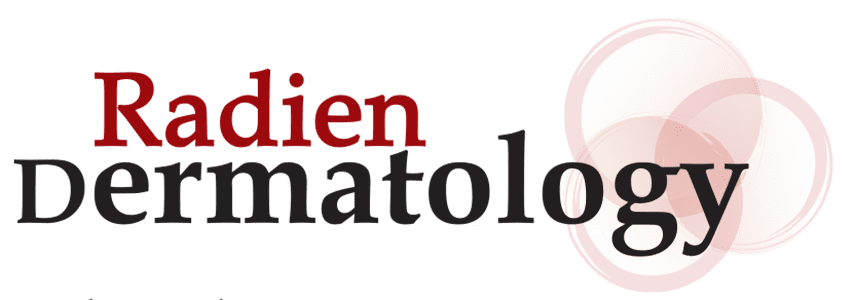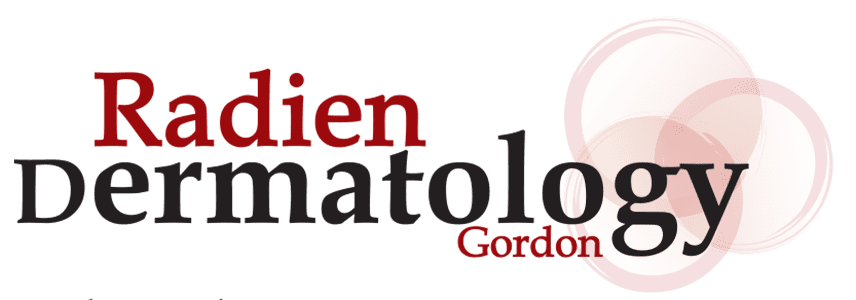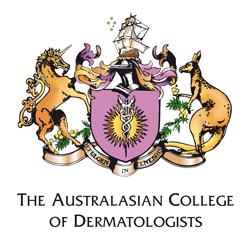The information listed in this section is to provide some background information on several common diseases. It is designed to give the reader a brief understanding of the diseases without providing specific treatment advice, which should be provided in partnership with your doctor or dermatologist.
Acne
Acne (or Acne Vulgaris) is a very common skin problem affecting nearly everyone from puberty onwards. The process that causes acne is complex. In simple terms, it is likely that the oil glands in the skin are too sensitive to the normal levels of male and female hormones in the body. This leads to many events. Too much oil and skin cells are produced forming a plug in the hair follicle, commonly called a blackhead, whitehead or comedo. Also, these follicles become irritated and inflamed, leading to red spots and pus. Bacteria are also involved making irritating enzymes and chemicals. Sometimes the inflammation becomes so severe that large lumps and cysts can form, leading eventually to scarring.
Despite popular belief, acne is not just a disease of teenagers and cannot be cured with just a few dabs of cream or a ‘magic cleanser’. Acne can last for years into early adulthood, and changes in nature over time. Thus acne treatment needs to be used long-term, and different treatments used to treat different stages of the disease. As there are different types of acne spots, and often at the same time, different acne treatments are used together to get the best result.
Treatment often involves several medications, in order to combat acne at several areas: oil production, comedo formation, bacteria and inflammation. Thus, your doctor may give you one or two creams, an antibiotic, or other anti-inflammatory medications.
Atopic Dermatitis
Atopic Eczema (also known as Atopic Dermatitis or just Eczema) is a very common dry skin condition that is often inherited. A patient with eczema can also have a personal or family history of hayfever or asthma, a situation that we call Atopy (thus the name Atopic Eczema). Atopic diseases are likely to represent an over-active immune system leading to disease.
One theory to the cause of eczema is that affected patients are missing an important molecule in the skin that forms part of the normal protective oily barrier. Thus they are born with a life-long tendency to a very dry, irritable skin. Having no barrier means the skin easily becomes dry and enflamed, leading to eczema. Also, allergens can enter and set up an allergic tendency. The key to managing eczema is to replace this barrier with regular moisturizing.
Eczema can affect any part of the skin. Infants often have it on the outside of the arms and legs, and if there are starting to learn to feed themselves irritation from foods and saliva can give kids facial eczema. Older kids and adults typically are affected on the skin folds at the elbows and knees. The eyelids, scalp, trunk, hands and feet can also be affected in some cases.
Some people grow out of their eczema, whilst others tend to have it throughout life and simply learn to cope well with it. Remember that the tendency to a dry, irritable skin is always there and that given the right conditions even an adult who has outgrown their childhood disease can still get patches of eczema.
As the skin does not have a proper barrier, the key to managing any severity of eczema is to apply generous amounts of moisturizers to reconstitute that barrier. A thick, creamy preparation should be applied head to toe on several occasions everyday. Steroid creams are used to reduce inflammation and itch, but regular moisturizing will keep the eczema away. Indeed, moisturizing will thus reduce the amount of steroids a patient will need long term. More extensive disease may need phototherapy, whilst there are those who only settle down with immune suppressing medications.
Chloasma/Melasma
Melasma is a common condition due to an excess of the skin’s normal pigmentation being deposited on the face. The pigment is typically found on the forehead, cheeks and upper lip area, but may be more extensive. It is harmless, but many do not like the blotchy appearance. Hormones [such as the oral contraceptive pill, and those released in pregnancy] and sun exposure make melasma worse. Those with darker skin types are also more prone.
Treatment can be successful, but can take a while and the disease can recur if patients do not practice sun protection or continue to take the oral contraceptive. Typically fading creams and chemical peels are used regularly over months.
Common Baldness
Genetically based balding is the most common hair loss disorder in humans, so common that some may consider it rather normal. Regardless, having a full head of hair is socially important for many of us, especially women.
Despite popular belief, common balding does not result from hairs falling out, but rather the hair follicles shrink over time. These follicles are genetically programmed to react to the normal levels of male hormones (androgens) produced by the body. These levels are normal, but the follicles are too sensitive to them. Some time after puberty, the follicles begin to shrink with each shortening hair cycle, producing a hair shaft that gets progressively shorter and thinner with each cycle. Once fully shrunk, the follicles are so small they only produce a tiny hair that makes no cosmetic impact. The process occurs at different rates, thus the scalp hair density tends to thin gradually rather than disappear all at once.
The process occurs in both men and women, but the patterns are different. Men tend to have a receding hairline and a bald patch that merge, eventually producing a ‘horseshoe’ at the back. In women, the frontal hairline is preserved and the scalp hair density progressively thins over the crown [top of the scalp]. They start to see more and more scalp through the sparse hairs.
Treatment is different between men and women, but both are aimed at decreasing the androgen stimulation of the hair follicle and thus prevention of the shrinking process. Unfortunately there is no cure; medication typically has to be taken long-term. Hair transplants are useful, where hair follicles from the back of the scalp are removed and placed into the balding areas. The procedures have to be used in conjunction with medication to preserve as much of the normal hairs as possible. Otherwise the natural progression of the hair loss will only leave the transplanted hairs, which will also look somewhat sparse (and silly).
Excessive Sweating (Hyperhidrosis)
In this condition, patients have an exaggerated tendency to sweat excessively. This can affect the armpits, palms, and/or soles of the feet. Apart from sweating due to changes in temperature and emotions, patients with hyperhidrosis can sweat without triggers during the course of the day. Clothes can be ruined and patients are often embarrassed when they have to shake hands. Holding pens and grips on sports gear can become problematic. Interestingly, sweating is often not a problem during sleep.
Many treatments are available, but not all patients necessarily respond. Potent topical antipersperants are often used first, before considering oral drugs or intradermal botulinum toxin injections. Importantly, your doctor has to rule out other causes of excessive sweating before any treatment is offered.
Psoriasis
Psoriasis is a complex illness that varies greatly between patients. Though a genetic predisposition is assumed, the inflammation in the plaques is likely to have an immune basis. It seems that the body’s immune cells send various chemical signals to the skin to make it inflamed and force the cells to replicate too quickly. It is an inflammatory skin disorder that features raised, red plaques full of silvery scales. These plaques can be tiny, but may also be large, thick and uncomfortable. Some patients have minimal involvement on the elbows and knees, whilst others can have disease in the hair and nails, and severe forms can affect the entire body.
Many treatments are available, and are aimed at reducing the inflammation or reducing the effect of the immune system. Topical cortisones, tars, phototherapy and oral immune suppressants may be used and are often prescribed in combination for best effect.
Rosacea
Rosacea is a common condition that tends to affect women more commonly. It is of unknown cause, but some researchers think that it may be a reaction to a microscopic mite that lives on oily skin. The rash occurs on the convex parts of the face, eg cheeks, forehead, nose and chin. The disease is persistent, but can be kept under long-term control.
There are several stages to the disease. Most will have a period of flushing and blushing, before the onset of fixed redness due to dilated (or ‘broken’) blood vessels. An inflammatory phase follows, with pimples and red dots. Hot drinks, spicy foods, exercise, and alcohol can trigger these features. Men can ultimately get a thickened and lumpy nose, often mistakenly assumed to be due to excess alcohol [not true!].
Antibiotic tablets and creams used long-term can control the inflammatory phase. Whilst lasers can target and remove the redness and blood vessels. Lumpy noses can be surgically treated or lasered.
Seborrhoeic Dermatitis
Seborrhoeic dermatitis (SD) is a reactive rash caused by a yeast infestation (Pityrosporum). This yeast is a commonly found on human skin and is readily transferred with normal social interaction. SD typically occurs on the face as a red rash with greasy scales mainly around the mid face, nose and eyebrows. It can also on other hair-bearing areas including the beard and trunk; ‘dandruff’ is SD occurring on the scalp. The yeast can be found on all hairy skin and thus treatment should involve all these sites.
The regular use of an anti-dandruff shampoo and a topical antifungal is useful in controlling the disease.
Steroid Creams
Steroid preparations applied to the skin are the mainstay of treating inflammatory skin disease. This form of treatment has been in existence for over 60 years. The corticosteroid molecules are absorbed into the skin and affects local immune white blood cells to stop producing inflammatory chemicals which lead to skin disease. Creams, ointments, lotions, foams, soaks and sprays, with different forms and strengths of steroids are available.
Weak steroids can be used safely on the face and skin folds, whilst stronger steroids are used elsewhere. Your doctor should be able to guide you appropriately; always get advice before using any steroid on a rash.
Many patients are concerned that steroids can have harmful effects. Some worry about ‘thinning of the skin’ and the production of obvious blood vessels. Though these events can occur, they are uncommon and typically due to the use of inappropriately strong preparations for unacceptably long periods. If steroids are only used on affected skin with close supervision by you doctor, these events are exceedingly rare. Always consult with your doctor if you are concerned about potential side effects.


